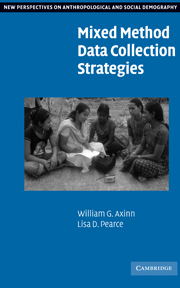Book contents
- Frontmatter
- Contents
- Acknowledgments
- Preface
- 1 Motivations for Mixed Method Social Research
- 2 Fitting Data Collection Methods to Research Aims
- 3 The Micro-Demographic Community Study Approach
- 4 Systematic Anomalous Case Analysis
- 5 Neighborhood History Calendars
- 6 Life History Calendars
- 7 Longitudinal Data Collection
- 8 Conclusion
- Notes
- Bibliography
- Index
2 - Fitting Data Collection Methods to Research Aims
Published online by Cambridge University Press: 10 December 2009
- Frontmatter
- Contents
- Acknowledgments
- Preface
- 1 Motivations for Mixed Method Social Research
- 2 Fitting Data Collection Methods to Research Aims
- 3 The Micro-Demographic Community Study Approach
- 4 Systematic Anomalous Case Analysis
- 5 Neighborhood History Calendars
- 6 Life History Calendars
- 7 Longitudinal Data Collection
- 8 Conclusion
- Notes
- Bibliography
- Index
Summary
In the social sciences, data collection methods are tools for measuring human behavior, human beliefs, or other aspects of the human population. In Chapter 1, we described the range of measurement tools commonly used in the social sciences and highlighted some of their similarities and differences. As we argued in Chapter 1, tools are not good or bad. They simply fit the purpose well or poorly. So if you wish to pound a nail into a piece of wood, a hammer fits the task well and a saw fits the job poorly. If, on the other hand, you wish to cut a piece of wood in half, a saw fits the job well and a hammer fits the job poorly. Hammers and saws are not good or bad. They are just more or less useful depending on the job you aim to do.
For many large projects, more than one tool is needed. Continuing with our analogy, using both a hammer and a saw allows you to accomplish things you could not accomplish with only one of these tools. The same is generally true in the research process. As we argued in the previous chapter, using multiple data collection methods usually provides a more comprehensive set of evidence for assessment, often raising the possibility that questions introduced by the use of one method can be answered by data collected with another method (Sieber 1973).
- Type
- Chapter
- Information
- Mixed Method Data Collection Strategies , pp. 28 - 53Publisher: Cambridge University PressPrint publication year: 2006



